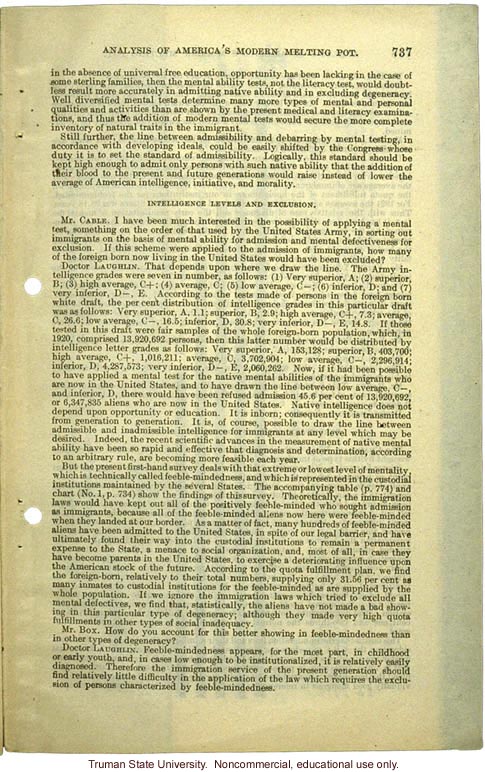Analysis of America's Modern Melting Pot. 737
in the absence of universal free education, opportunity has been lacking in the case of some sterling families, then the mental ability tests, not the literacy test, would doubtless result more accurately in admitting native ability and in excluding degeneracy. Well diversified mental tests determine many more types of mental and personal qualities and activities than are shown by the present medical and literacy examinations, and thus the addition of modern mental tests would secure the more complete inventory of natural traits in the immigrant.
Still further, the line between admissibility and debarring by mental testing, in accordance with developing ideals, could be easily shifted by the Congress whose duty it is to set the standard of admissibility. Logically, this standard should be kept high enough to admit only persons with sch native ability that the addition of their blood to the present and future generations would raise instead of lower the average of American intelligence, initiative, and morality.
Intelligence Levels and Exclusion.
Mr. Cable. I have been much interested in the possibility of applying a mental test, something on the order of that used by the United States Army, in sorting out immigrants on the basis of mental ability for admission and mental defectiveness for exclusion. If this scheme were applied to the admission of immigrants, how many of the foreign born now living in the United States would have been excluded?
Doctor Laughlin. That depends upon where we draw the line. The Army intelligence grades were seven in number, as follows: (1) Very superior, A; (2) superior, B; (3) high average, C+; (4) average, C; (5) low average, C-; (6) inferior, D; and (7) very inferior, D-, E. According to the tests made of persons in the foreign born white draft, the per cent distribution of intelligence grades in this particular draft was as follows: Very superior, A 1.1; superior, B, 2.9; high average, C+, 7.3; average, C, 26.6; low average, C-, 16.5; inferior, D, 30.8; very inferior, D-, E, 14.8. If those tested in this draft were fair samples of the whole foreign-born population, which, in 1920, comprised 13,920,692 persons, then this latter number would be distributed by intelligence letter grades as follows: Very superior, A, 153,128; superior, B, 403,700; high average, C+, 1,016,211; average, C, 3,702,904; low average, C-, 2,296,914; inferior, D, 4,287,573; very inferior, D-, E, 2,060,262. Now, if it had been possible to have applied a mental test for the native mental abilities of the immigrants who are now in the United States, and to have drawn the line between low average, C-, and inferior, D, there would have been refused admission 45.6 per cent of 13,920,692,or 6,347,835 aliens who are now in the United States. Native intelligence does not depend upon opportunity or education. It is inborn; consequently it is transmitted from generation to generation. It is, of course, possible to draw the line between admissible and inadmissible intelligence for immigrants at any level which may be desired. Indeed, the recent scientific advances in the measurement of native mental ability have been so rapid and effective that diagnosis and determination, according to an arbitrary rule, are becoming more feasible each year.
But the present first-hand survey deals with that extreme or lowest level of mentality, which is technically called feeble-mindedness, and which is represented in the custodial institutions maintained by the several States. The accompanying table (p. 774) and chart (No. 1, p. 734) show the findings of this survey. Theoretically, the immigration laws would have kept out all of the positively feeble-minded who sought admission as immigrants, because all of the feeble-minded aliens now here were feeble-minded when they landed at our border. As a matter of fact, many hundreds of feeble-minded aliens have been admitted to the United States, in spite of our legal barrier, and have ultimately found their way in the custodial institutions to remain a permanent expense to the State, a menace to social organization, and, most of all, in case they have become parents in the United States, to exercise a deteriorating influence upon the American stock of the future. According to the quota fulfillment plan, we find the foreign-born, relatively to their total numbers, supplying only 31.56 per cent as many inmates to custodial institutions for the feeble-minded as are supplied by the whole population. If we ignore the immigration laws which have tried to exclude all mental defectives, we find that, statistically, the aliens have not made a bad showing in this particular type of degeneracy; although they made very high quota fulfillments in other types of social inadequacy.
Mr. Box. How do you account for the better showing in feeble-mindedness than in other types of degeneracy?
Doctor Laughlin. Feeble-mindedness appears, for the most part, in childhood or early youth, and, in cases low enough to be institutionalized, it is relatively easily diagnosed. Therefore the immigration service of the present generation should find relatively little difficulty in the application of the law which requires the exclusion of persons characterized by feeble-mindedness.


